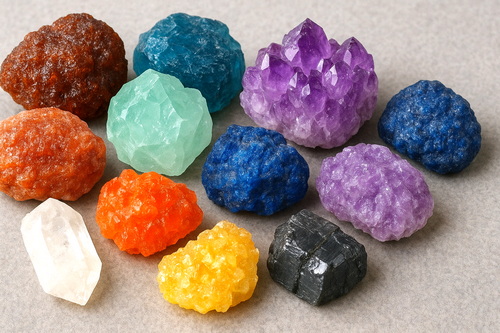
Minerals FAQ Overview
This FAQ page brings together the most common questions from across HowardFenstermanMinerals.com — covering the science, structure, and beauty of Earth’s minerals. Whether you’re a collector, student, or geology enthusiast, you’ll find clear answers about how minerals form, what makes them unique, and how to identify and appreciate them. The topics below summarize key points from our in-depth guides on quartz, emeralds, bismuth, and other remarkable specimens featured throughout the site.
What are minerals?
Minerals are naturally occurring, inorganic substances with a definite chemical composition and crystalline structure. They form the building blocks of rocks and are vital to both Earth’s geology and human industry.
How are minerals formed?
Minerals form through various geological processes such as crystallization from molten magma, evaporation of mineral-rich water, or alteration under pressure and temperature deep within the Earth.
What’s the difference between a rock and a mineral?
A mineral is a pure substance with a defined formula, while a rock is a combination of one or more minerals bound together. For example, granite is composed of quartz, feldspar, and mica.
Which minerals are considered gemstones?
Gemstones include minerals such as emeralds, quartz, opal, malachite, bismuth, tanzanite, alexandrite, and ruby. These are valued for their beauty, rarity, and durability.
Why do minerals have different colors?
Mineral color depends on impurities, chemical composition, and crystal structure. For instance, trace elements of chromium make emeralds green, while iron gives quartz a purple hue (amethyst).
What are metamorphic, igneous, and sedimentary rocks?
-
Igneous: Formed from cooled magma (e.g., granite).
-
Sedimentary: Created from compressed layers of sediments (e.g., limestone).
-
Metamorphic: Result from existing rocks changing under heat and pressure (e.g., marble).
What are some of the rarest minerals in the world?
Some of the rarest include Painite, Jeremejevite, Red Beryl (Bixbite), and Taaffeite — all featured in detail on this site.
What are minerals used for?
Minerals have industrial, technological, and ornamental uses:
-
Titanium for aerospace and medicine
-
Quartz for electronics
-
Bismuth for pharmaceuticals
-
Malachite and Jasper for jewelry and pigments
How can I identify a mineral?
Identification involves testing for hardness (Mohs scale), color, luster, streak, density, and crystal shape. Our Quartz Guide and other pages provide detailed examples.
Where can minerals be found?
Minerals are found worldwide — in caves, mountain ranges, riverbeds, and mines. Gem hunters often explore regions rich in metamorphic rocks, volcanic activity, or sedimentary deposits.
What are tumbled stones?
Tumbled stones are polished mineral specimens created by placing rough stones in a rock tumbler with grit and water to smooth and shine them. They’re popular for collections and metaphysical uses.
What gives minerals their healing or metaphysical properties?
While not scientifically proven, many believe gemstones like amethyst, jade, and turquoise promote emotional balance and physical well-being — a belief rooted in ancient cultural traditions.
Why do some people think minerals have special powers?
Cultures from older generations, going back to antiquity, believed that certain minerals helped with diseases. This is not a routine therapy these days.
